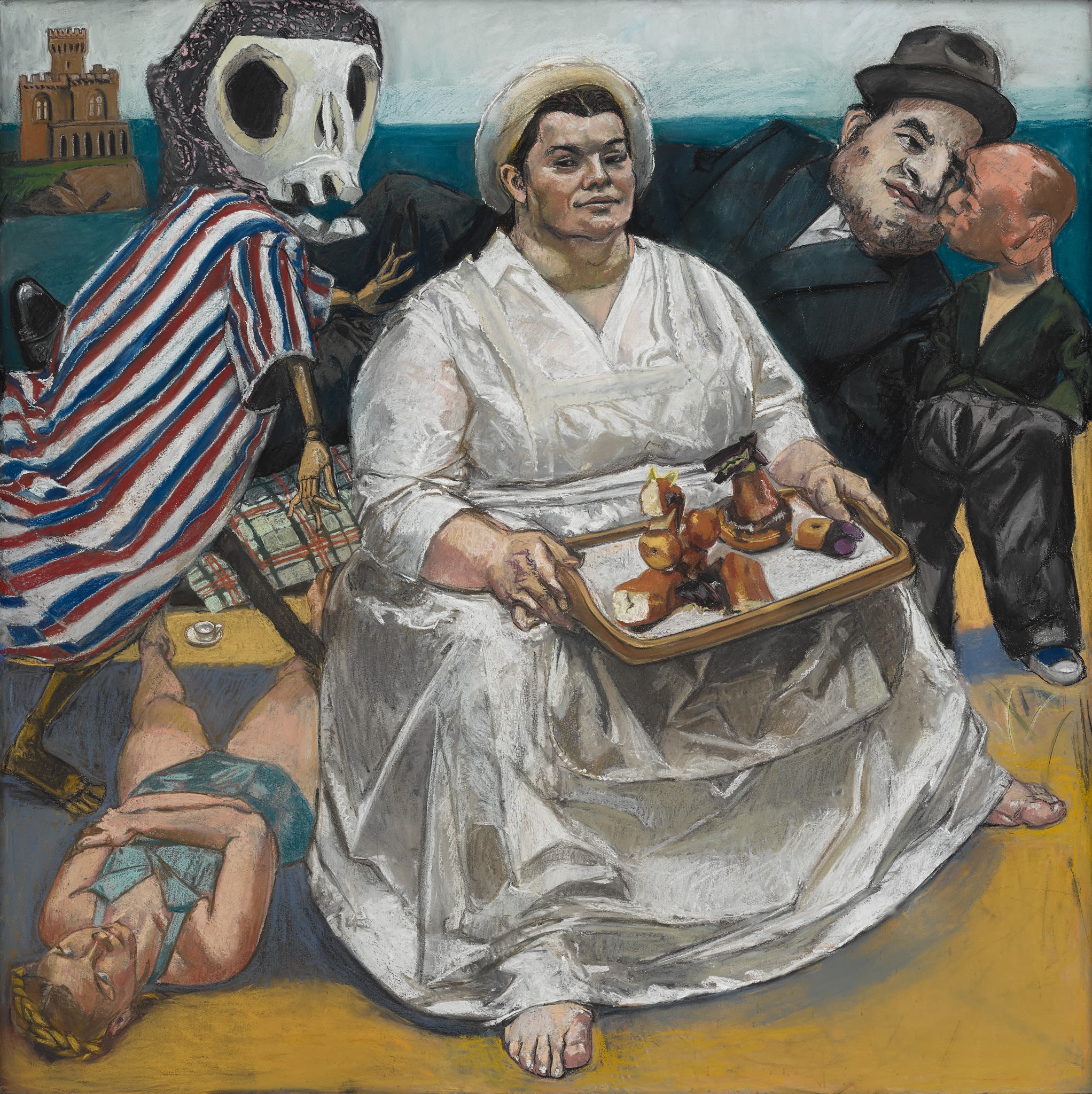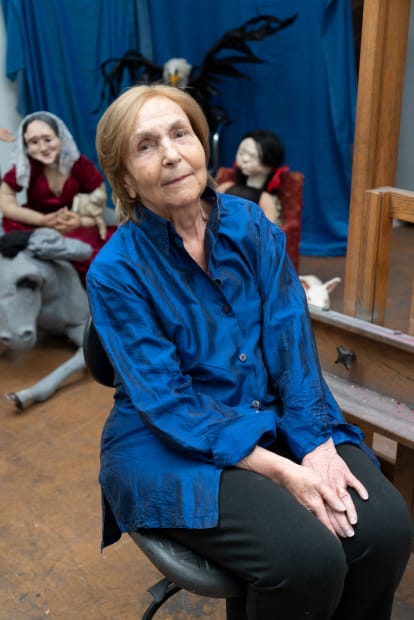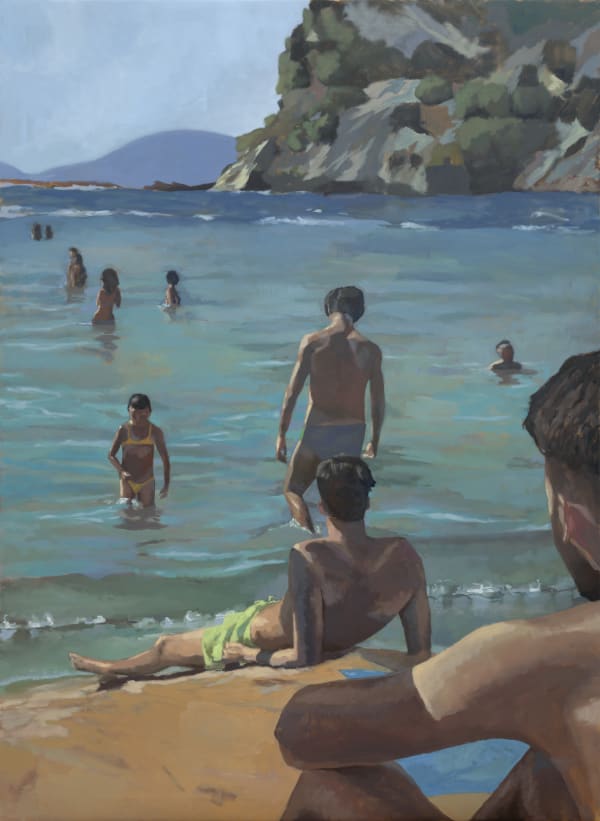Completed in 2004, this major work by Paula Rego conjures an ambiguous tale from sun and shadow, illuminating illicit encounters and power struggles under the watchful eye of The Cake Woman.
Drawing upon details of her extraordinary life, on politics and art history, literature, folk legends, myths and fairy tales, Paula Rego’s art is an unflinching exploration of human relationships, her piercing eye trained on the established order as well as the codes, structures and dynamics of power that embolden or repress the characters she depicts.
In this key 2004 work, these themes are woven around wartime memories from Rego's childhood, triggered by a meeting in 2003 with her former dance teacher, Miss Cook. Recollections of life in Estoril during the Second World War, when Portugal was neutral under Salazar's regime and the seaside town became a hub for exiles, spies and refugees, were entangled with Rego's present-day concerns during the making of this extraordinary work.
-
‘The women in her art always know more…’
– Adrian Searle, The Guardian
-
 Paula Rego, The Cake Woman, 2004Pastel on paper on aluminium150 x 150 cm
Paula Rego, The Cake Woman, 2004Pastel on paper on aluminium150 x 150 cm
59 x 59 in -
‘This familiar character on Portugal’s beaches in the 1940s has been transformed into a menacing Sibyl. With her ambivalent smile and androgynous, mighty form, she is reminiscent of Michelangelo’s oracles in the Sistine Chapel.’
– Skye Sherwin, The Guardian -
Throughout her career, Paula Rego was never afraid to confront the strange, difficult or sinister and, as with many of her works, The Cake Woman was triggered by a personal experience with which a complex mixture of feelings, memories, present day desires and fears became fused.
In this instance, the initial springboard was a meeting in 2003 with Rego’s former dance teacher, Miss Cook, a figure from the artist’s childhood in Estoril during the Second World War. Rego grew up in a house close to the casino, at that time a meeting place for Allied and Nazi spies. Miss Cook played the piano in the casino and, encountering her many decades later, the artist was spurred to conduct further research into Estoril during the war.
-
‘I went to the Imperial War Museum library to study what had happened in Portugal during the war… What people went through, what the atmosphere was like. It was fascinating, because I actually lived there. I remember my parents going out in the evening to the Wonder Bar. I remember when Paris fell – my mother cried, and she went to the station, weeping, to catch the train. A German family that lived on the next road were doing the Hitler salute in front of her. It was like that. You would go to the casino, and one table would have German spies, and another would have English spies.’
– Paula Rego interviewed by Marco Livingstone, 2006
-
In The Cake Woman, Rego assembles a cast that, rather than illustrate a specific narrative, alludes to the currents of the times, their strange atmosphere, with Estoril becoming a hub for European royalty, spies and political exiles, earning it the nickname ‘The Coast of Kings’, while also becoming home to refugees from Poland and elsewhere, many of whom brought with them harrowing stories of their experiences.
The central figure, dominating the image in her white dress and pinafore, casts a knowing eye on the unfolding scene around her while proffering a tray of delicacies. To her right, we see a figure that at first might be considered a bather but is thought likely to be a refugee. To her left, Rego creates a troubling encounter between a man and a child-size figure, while the macabre figure of Death, wearing a striped bathing robe, enjoys the sun and the cakes of the Portuguese Riviera.
-
-
Yet, at the same time there are intimations of contemporary life, even of history repeating itself, with The Cake Woman becoming a prophetic, Sibyl-like figure, as noted by Skye Sherwin in The Guardian. A work on paper from the same period, entitled Tamariz AKA The Beach in Estoril, depicts scenes of people unworriedly, perhaps obliviously, enjoying life on the Portuguese Riviera. For Rego, there were troubling echoes of comfortable bourgeois life in Estoril in the 1940s in the situation in London at the time, with life going on as usual while so many were suffering in the Middle East.As noted by Nick Willing, ‘The Cake Woman cannot be seen as a simply nostalgic picture that Rego created to revisit childhood memories. Placed within the context in which it was made – with the violence of the Iraq War at the centre of media coverage – the work transcends its historical setting, reminding us that we continue to overlook state-sponsored violence and suffering…’
‘The Cake Woman cannot be seen as a simply nostalgic picture that Rego created to revisit childhood memories. Placed within the context in which it was made – with the violence of the Iraq War at the centre of media coverage – the work transcends its historical setting.’
– Nick Willing -

Paula Rego, War, 2003
Pastel on paper on aluminium
Collection Tate
© Estate of Paula Rego -
‘Process is part of it, I don’t want to get exactly what I want the first time, because, you see, the changing it, the pushing it around, shoving it, makes it come alive…’
– Paula Rego -
-

-
‘Her work is all an exorcism.
Life – ours as well as hers – courses through it.’– Adrian Searle, The Guardian
-
Paula Rego
→ Visit Artist Page -
About the artist
 Paula Rego in her studio, 2021. Photograph © Nick Willing
Paula Rego in her studio, 2021. Photograph © Nick Willing -
Explore gallery exhibitions
-

Chantal Joffe: I Remember
14 November 2025 – 17 January 2026 London Gallery IThe exhibition takes its title from Joe Brainard’s iconic memoir and is inspired by the late American writer’s poetic prompts that evoke the atmosphere and time of memories. Joffe’s paintings... -

The Stories We Tell: Tidawhitney Lek, Emil Sands, Khalif Tahir Thompson
14 November 2025 – 17 January 2026 London Gallery II, Miro PresentsThe first significant introduction of three emerging artists, all born in the 1990s, to a London audience. -

Richard Ayodeji Ikhide: Incroci del Passato (Crossroads of the Past)
1 November – 13 December 2025 Miro Presents, VeniceAn exhibition of new tempera paintings Ikhide began during a residency with the gallery in Venice in spring 2025. Working in egg tempera on panel for the first time, he...
-
-
LIVE / ARCHIVE
An immersive journey through our programmatic strandsExperience our galleries from wherever you are in the world







